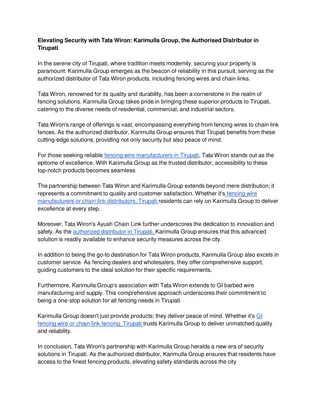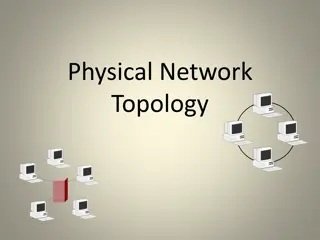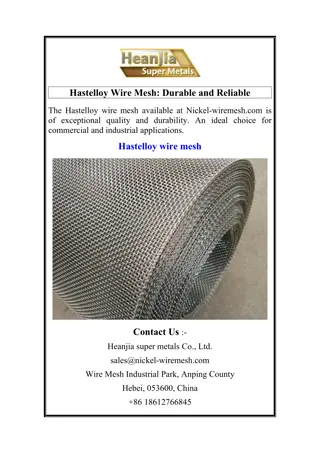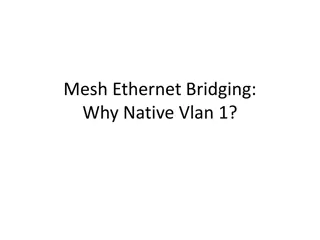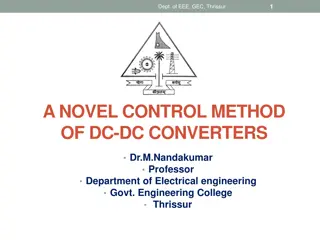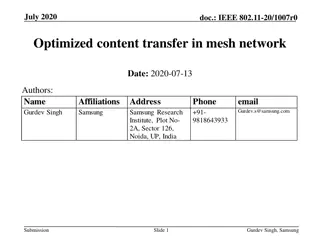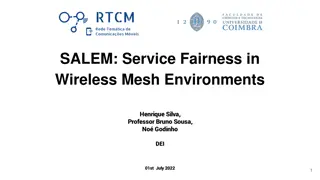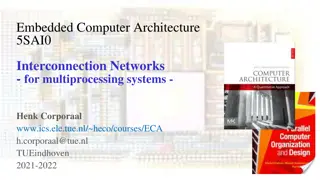Understanding Mesh and Star Network Topologies
Network topology plays a crucial role in network performance and maintenance costs. Mesh topology connects every device with a dedicated link, providing reliability and security. On the other hand, star topology connects devices to a central hub, ensuring communication through the hub. Explore the advantages and disadvantages of both mesh and star topologies in computer networking.
Download Presentation

Please find below an Image/Link to download the presentation.
The content on the website is provided AS IS for your information and personal use only. It may not be sold, licensed, or shared on other websites without obtaining consent from the author. Download presentation by click this link. If you encounter any issues during the download, it is possible that the publisher has removed the file from their server.
E N D
Presentation Transcript
Network Topology A network topology is the arrangement of a network , includes nodes and connecting lines. It can be defined in two ways, physical topology seven types of topologies in Network. They are point to point, bus, star, ring, mesh, tree and hybrid. Computer Network Topology Geometric representation of how the computers are connected to each other is known as topology. Mesh Star Bus Ring Hybrid and logical topology. There are
Importance of network topology Plays a crucial role in performance. Helps reduce the operational and maintenance costs such as cabling costs. A network topology is a factor in determining the media type to be used to cable a network. Error or fault detection is made easy using network topologies.
Mesh Topology In mesh topology each device is connected to every other device on the network through a dedicated point-to-point link. When we say dedicated it means that the link only carries data for the two connected devices only. Lets say we have n devices in the network then each device must be connected with (n-1) devices of the network. Number of links in a mesh topology of n devices would be n(n-1)/2.
Advanatges of Mesh topology 1. No data traffic issues as there is a dedicated link between two devices which means the link is only 2. Mesh topology is reliable and robust as failure of one link doesn t affect other links and the communication between other devices on the network. 3. Mesh topology is secure because there is a point to point link thus unauthorized access 4. Fault detection is easy. available for those two devices. is not possible.
Disadvantages of Mesh Topology 1. Amount of wires required to connected each system is tedious and headache. 2. Since each device needs to be connected with other devices, number of I/O ports required 3. Scalability issues because a device cannot be connected with large number of devices with a dedicated point to point link. must be huge.
Star Topology In star topology each device in the network is connected to a central device called hub. Unlike Mesh topology, star topology doesn t allow direct communication between devices, a device must have to communicate through hub. If one device wants to send data to other device, it has to first send the data to hub and then the hub transmit that data to the designated device.
Advantages of Star topology 1. Less expensive because each device only need one I/O port and needs to be connected with hub with one link. 2. Easier to install 3. Less amount of cables required because each device needs to be connected with the hub only. 4. Robust, if one link fails, other links will work just fine. 5. Easy fault detection because the link can be easily identified.
Disadvantages of Star topology 1. If hub goes down everything goes down, none of the devices can work without hub. 2. Hub requires more resources and regular maintenance because it is the central system of star topology.
Bus Topology In bus topology there is a main cable and all the devices are connected to this main cable through drop lines. There is a device called tap that connects the drop line to the main cable. Since all the data is transmitted over the main cable, there is a limit of drop lines and the distance a main cable can have.
Advantages of bus topology 1. Easy installation, each cable needs to be connected with backbone cable. 2. Less cables required than Mesh and star topology
Disadvantages of bus topology 1. Difficultly in fault detection. 2. Not scalable as there is a limit of how many nodes you can connect with backbone cable.
Ring Topology In ring topology each device is connected with the two devices on either side of it. There are two dedicated point to point links a device has with the devices on the either side of it. This structure forms a ring thus it is known as ring topology. If a device wants to send data to another device then it sends the data in one direction, each device in ring topology has a repeater, if the received data is intended for other device then repeater forwards this data until the intended device receives it.
Advantages of Ring Topology 1. Easy to install. 2. Managing is easier as to add or remove a device from the topology only two links are required to be changed.
Disadvantages of Ring Topology 1. A link failure can fail the entire network as the signal will not travel forward due to failure. 2. Data traffic issues, since all the data is circulating in a ring.
Hybrid Topology A combination of two or more topology is known as hybrid topology. For example a combination of star and mesh topology is known as hybrid topology.
Advantages of Hybrid topology 1. We can choose the topology based on the requirement for example, scalability is our concern then we can use star topology instead of bus technology. 2. Scalable as we can further connect other computer networks with the existing networks with different topologies.
Disadvantages of Hybrid topology 1. Fault detection is difficult. 2. Installation is difficult. 3. Design is complex so maintenance is high thus expensive.



